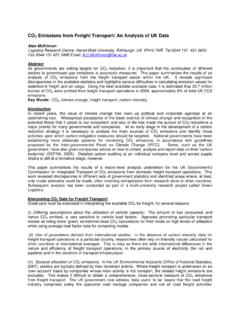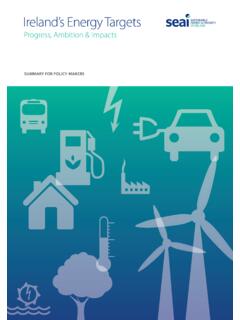Transcription of ASIN ORIENTED STRATEGIES FOR CO2 ENHANCED OIL …
1 BASIN ORIENTED STRATEGIES FOR CO2 ENHANCED OIL RECOVERY: PERMIAN BASINF ebruary 2006 Prepared for Department of EnergyOffice of Fossil Energy Office of Oil and Natural GasPrepared byAdvanced Resources International Disclaimer This report was prepared as an account of work sponsored by an agency of the United States Government. Neither the United States nor the United States Department of Energy, nor any of their employees, makes any warranty, express or implied, or assumes any legal liability or responsibility of the accuracy, completeness, or usefulness of any information, apparatus, product, or process disclosed, or represents that its use would not infringe privately owned rights.
2 The findings and conclusions in this report are those of the authors and do not necessarily represent the views of the Department of Energy. BASIN ORIENTED STRATEGIES FOR CO2 ENHANCED OIL RECOVERY: PERMIAN BASIN Prepared for Department of Energy Prepared by Advanced Resources International February 2006 i February 2006 TABLE OF CONTENTS 1. SUMMARY OF FINDINGS INTRODUCTION ALTERNATIVE OIL RECOVERY STRATEGIES AND SCENARIOS OVERVIEW OF FINDINGS ACKNOWLEDGEMENTS 2.
3 INTRODUCTION CURRENT SITUATION BACKGROUND PURPOSE KEY ASSUMPTIONS TECHNICAL OBJECTIVES OTHER ISSUES 3. OVERVIEW OF PERMIAN BASIN OIL PRODUCTION HISTORY OF OIL PRODUCTION EXPERIENCE WITH IMPROVED OIL RECOVERY THE STRANDED OIL PRIZE REVIEW OF PRIOR STUDIES 4. MECHANISMS OF CO2-EOR MECHANISMS OF MISCIBLE CO2-EOR MECHANISMS OF IMMISCIBLE CO2-EOR INTERACTIONS BETWEEN INJECTED CO2 AND RESERVOIR OIL 5. STUDY METHODOLOGY OVERVIEW ASSEMBLING THE MAJOR OIL RESERVOIRS DATA BASE SCREENING RESERVOIRS FOR CO2-EOR CALCULATING MINIMUM MISCIBILITY PRESSURE CALCULATING OIL RECOVERY ASSEMBLING THE COST MODEL CONSTRUCTING AN ECONOMICS MODEL PERFORMING SCENARIO ANALYSES 6.
4 RESULTS BY STATE NEW MEXICO WEST TEXAS ii February 2006 LIST OF FIGURES Figure 1 Impact of Advanced Technology and Improved Financial Conditions on Economically Recoverable Oil from the Permian Basin s Major Reservoirs Using CO2-EOR (Million Barrels) Figure 2 Locations of Major Permian Basin Oil Fields Amenable to CO2-EOR Figure 3 Existing CO2 Pipelines and Sources in the Permian Basin Figure 4 Permian Basin Historical Crude Oil Production since 1970 Figure 5 One-Dimensional Schematic Showing the CO2 Miscible Process Figure 6A Carbon Dioxide, CH4 and N2 densities at 105 F Figure 6B Carbon Dioxide, CH4 and N2 viscosities at 105 F Figure 7A Relative Oil Volume vs.
5 Pressure for a Light West Texas Reservoir Fluid Figure 7B Oil Swelling Factor vs. Pressure for a Heavy Oil in Turkey Figure 8 Viscosity Reduction Versus Saturation Pressure Figure 9 Estimating CO2 Minimum Miscibility Pressure Figure 10 Correlation of MW C5+ to Tank Oil Gravity Figure 11 New Mexico History of Oil Production Rates Figure 12 Large New Mexico Oil Fields Figure 13 West Texas History of Oil Production Rates Figure 14 Large West Texas Oil Fields LIST OF TABLES Table 1 Permian Basin s Oil Resource and Reservoirs Table 2 Permian Basin s Stranded Oil Resources Amenable to CO2-EOR Table 3 Technically Recoverable Resource Using Miscible CO2-EOR Table 4 Economically Recoverable Resources Under
6 Scenario #1: Traditional Practices CO2-EOR Table 5 Economically Recoverable Resources - Alternative Scenarios Table 6 Potential CO2 Supply Requirements in the Permian Basin Scenario #4 ( Ample Supplies of CO2 ) Table 7 Matching of CO2-EOR Technology with the Permian Basin s Oil Reservoir. Table 8 Crude Oil Annual Production, Ten Largest Permian Basin Oil Fields, 2001-2003 (Million Barrels per Year) Table 9 Selected Major Oil Fields of the Permian Basin Favorable for CO2 EOR Table 10 Reservoir Data Format: Major Oil Reservoirs Data Base Table 11 Permian Basin Oil Reservoirs Screened Acceptable for CO2-EOR Table 12 Economic Model Established by the Study Table 13 Recent History of New Mexico Oil Production Table 14 Status of Large New Mexico Oil Fields/Reservoirs (as of 2002) Table 15 Reservoir Properties and Improved Oil Recovery Activity, Large New Mexico Oil Fields/Reservoirs Table 16 Past and Current CO2-EOR Project/Pilot Production, New Mexico.
7 Table 17 Economic Oil Recovery Potential Under Two Technologic Conditions, New Mexico Table 18 Economic Oil Recovery Potential with More Favorable Financial Conditions, New Mexico iii February 2006 Table 19 Recent History of West Texas Oil Production Table 20 Status of Large West Texas Oil Fields/Reservoirs (as of 2002) Table 21 Reservoir Properties and Improved Oil Recovery Activity, Large West Texas Oil Fields/Reservoirs Table 22 Past and Current CO2-EOR Project/Pilot Production, West Texas Table 23 Economic Oil Recovery Potential Under Two Technologic Conditions, West Texas Table 24 Economic Oil Recovery Potential with More Favorable Financial Conditions, West Texas 1-1 February 2006 1.
8 SUMMARY OF FINDINGS INTRODUCTION. The oil and gas producing regions of the Permian Basin, in New Mexico and West Texas (RR Districts 8 and 8A) have an original oil endowment of billion barrels. Of this, billion barrels or 35% will be recovered. As such, nearly billion barrels of oil will be left in the ground, or stranded , following the use of today s oil recovery practices. A major portion of this stranded oil is in reservoirs that appear to be technically and economically amenable to ENHANCED oil recovery (EOR) using carbon dioxide (CO2) injection. This report evaluates the future oil recovery potential in the large oil fields of the Permian Basin and the barriers that stand in the way of realizing this potential.
9 The report then discusses how a concerted set of basin ORIENTED STRATEGIES could help the Permian Basin s oil production industry overcome these barriers and capture the large stranded oil prize. ALTERNATIVE OIL RECOVERY STRATEGIES AND SCENARIOS. The report sets forth four scenarios for using CO2-EOR to recover stranded oil in the Permian Basin producing region. The first scenario captures how CO2-EOR technology has been applied and has performed in the past. This low technology, high-risk scenario is called Traditional Practices . The second scenario, entitled State-of-the-art , assumes that the technology progress in CO2-EOR, achieved in recent years, is successfully applied in the Permian Basin.
10 In addition, this scenario assumes that a comprehensive program of research, pilot tests and field demonstrations will help lower the risks inherent in applying new technology to these complex Permian Basin oil reservoirs. 1-2 February 2006 The third scenario, entitled Risk Mitigation examines how the economic potential of CO2-EOR could be increased through a strategy involving state production tax reductions, federal investment tax credits, royalty relief and/or higher world oil prices that together would add an equivalent $10 per barrel to the price that the producer uses for making capital investment decisions for CO2-EOR. The final scenario, entitled Ample Supplies of CO2, examines a setting where low-cost, EOR-ready CO2 supplies are aggregated from various industrial and natural sources.










